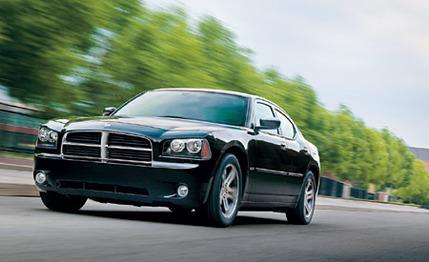
 Road Test
Road Test
In 1844, Alexandre Dumas wrote Les Trois Mousquetaires. The best-known of the protagonists was D'Artagnan. Then there was, uh, Porthos. And finally came Curly. Maybe it was Annette. In like fashion, DaimlerChrysler has trotted out its own trio of swarthy swordsmen, led initially by the popular and potent Chrysler 300 and Dodge Magnum and followed now by the Charger. All three benefit from the same 120.0-inch Mercedes-Benz- derived chassis, and not surprisingly, all three drive similarly. What is surprising is that the Charger shares not a single body panel with its brother mousquetaires and is most obviously differentiated from the 300 by its rear-three-quarter haunches-"kangaroo hips," as one onlooker called them-and by a grille that doesn't so earnestly mimic Jay Leno's chin. The Dodge guys insist that the four round taillamps recollect those on a 1968 Charger. See 'em? No? That's because the lamps are hidden beneath lenses apparently plucked from a Stratus. In fact, if you recognize any familiar Charger styling cues, give us a shout.
There are, incredibly, five Charger chargé d'affaires. The bottom-feeder SE ($22,295) features a 250-hp, 3.5-liter V-6 and includes a ton of stuff-17-inch tires, traction control, ABS, a CD player, stability control. It's more fun to drive than a V-6 Toyota Camry and is a lot rarer, although that may change if Dodge achieves its goal of selling a quarter of all Chargers to fleets-among them fuzz fleets, so commit this car's grille to memory now. There's another V-6 iteration, the SXT ($25,995), with lots more stuff standard. Next comes the R/T, with leather seats and the multidisplacement 340-horse Hemi ($29,995). Let us pause, here, to repeat that-a 340-hp rear-drive sedan for 30 grand, the sort of fun-to-dollar ratio that recollects, say, a Mustang GT, whose two doors remind us that the original Charger, alas, was also a coupe. For an extra $1600, you can order your R/T with the Road/Track Performance Group-no Car and Driver option was even considered, the jerks-which includes firmer self-leveling shocks, 18-inch Michelins, tighter "9-land" steering (our guess is that it's the G7 nations plus Alabama and Arkansas), beefier seat bolsters, and an extra 10 ponies summoned mostly via a center muffler with a straighter pass-through and a huskier singing voice. That's the car we selected for this test-an R/T with R/T, as it were. Next comes the Charger Daytona R/T ($32,495), identical to our tester except for a Pep Boys decklid spoiler and the billboard-size words "HEMI" and "DAYTONA" reversed out of flat-black paint, demonstrating to passing constables that you are a person of limited judgment and excess cash. And later this fall will come the SRT8 with a 425-hp Hemi-the ultimate Charger-whose price has yet to be fixed. No all-wheel-drive Charger will be offered.
All five include a Mercedes-designed five-speed automatic with a slick manumatic that is perfectly positioned and quick to respond-bump left for downshifts, right for upshifts. During our tests, the transmission seemed telepathic about summoning the correct gear and snicked off seamless WOT upshifts. Our lone beef was one of those Are-you-sure-you-want-to-do-this? pauses before kickdowns from fifth.
Mercedes likewise penned the steering rack, and it's a beaut. On freeways, the front tires evince fierce dedication to straight-ahead, and the slight on-center slack you notice in a 300C, which we drove back-to-back, has been eliminated. For the most part, effort is on the high side-and we'd have preferred to feel a little more road texture-but the heaviness disappears at parking speeds. In any event, the wheel itself is NASCAR large, so there's no trouble deriving leverage.
We hammered our Charger around Virginia International Raceway and were surprised at the car's balance and general neutrality. It's difficult to rotate the tail-the stability control can't be completely disabled and is not enamored of power oversteer-but you can slide the car in modest but controllable drifts that would have amused even Mel Kenyon.
Brake feel is terrific and allows your foot to reliably sense the transition to anti-lock. Better still is the 169-foot stopping distance, impressive for a two-ton anything. The R/T's rotors are big (13.6 inches fore, 12.6 inches aft), and we noticed virtually no fade, even at the racetrack.
Throughout, the Charger's body motions remained as studiously supervised as a Vassar faculty party. The firmer optional dampers eliminated even the minor dive and squat we've noticed in the 300C. In fact, during an 800-mile two-stop blast from VIR to Detroit, the ride-and-handling trade-off proved nothing short of miraculous until we encountered Michigan's Baghdad-quality potholes. Even then, the platform held as firmly and shiver-free as a bridge abutment, and no subassemblies rattled or squeaked. Nevertheless, if you dwell in a frost-heave state and want to ensure that your Charger remains an all-star long-distance cruiser, you may want to dial back to the standard R/T suspension. At least sample it.